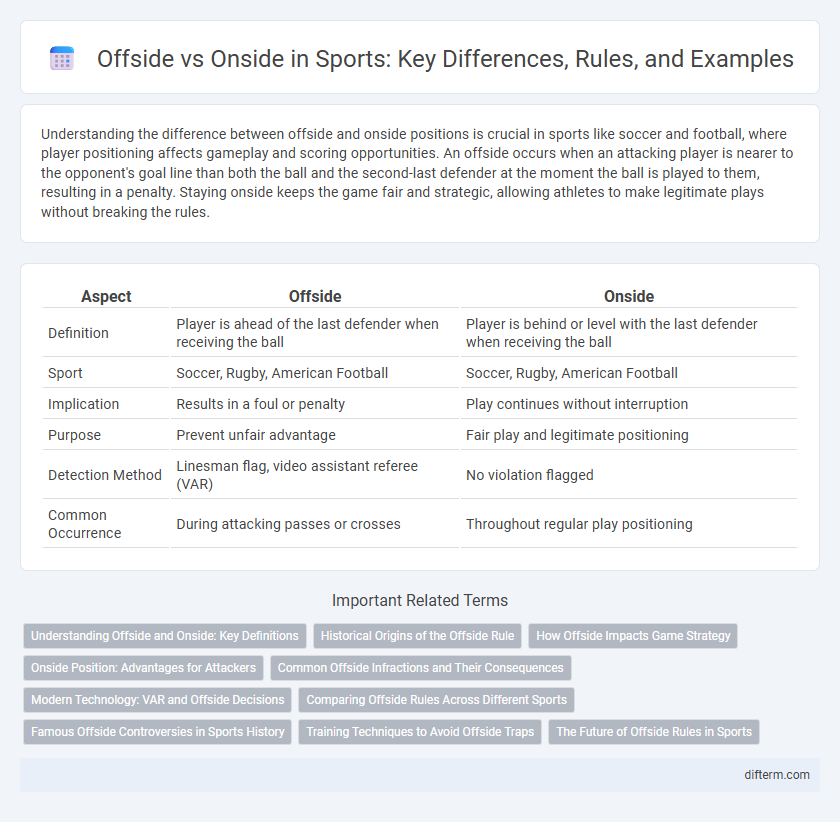Understanding the difference between offside and onside positions is crucial in sports like soccer and football, where player positioning affects gameplay and scoring opportunities. An offside occurs when an attacking player is nearer to the opponent's goal line than both the ball and the second-last defender at the moment the ball is played to them, resulting in a penalty. Staying onside keeps the game fair and strategic, allowing athletes to make legitimate plays without breaking the rules.
Table of Comparison
| Aspect | Offside | Onside |
|---|---|---|
| Definition | Player is ahead of the last defender when receiving the ball | Player is behind or level with the last defender when receiving the ball |
| Sport | Soccer, Rugby, American Football | Soccer, Rugby, American Football |
| Implication | Results in a foul or penalty | Play continues without interruption |
| Purpose | Prevent unfair advantage | Fair play and legitimate positioning |
| Detection Method | Linesman flag, video assistant referee (VAR) | No violation flagged |
| Common Occurrence | During attacking passes or crosses | Throughout regular play positioning |
Understanding Offside and Onside: Key Definitions
Offside occurs when an attacking player is positioned nearer to the opponent's goal line than both the ball and the second-last defender at the moment the ball is played to them, leading to an infringement and stoppage of play. Onside means the player is level with or behind the second-last defender when receiving the ball, allowing the attack to proceed legally. Understanding these definitions is essential for interpreting game strategies and referee decisions in sports like soccer and hockey.
Historical Origins of the Offside Rule
The offside rule in sports, particularly soccer, originated in the 19th century to prevent players from gaining an unfair advantage by positioning themselves nearer to the opponent's goal than both the ball and the second-to-last defender. Early versions of the rule appeared in English public school games, evolving significantly with the formation of the Football Association in 1863, which standardized its enforcement to maintain fair play and game flow. The historical development of the offside rule reflects efforts to balance offensive opportunities with defensive strategies, shaping modern soccer's tactical complexity.
How Offside Impacts Game Strategy
Offside rules significantly influence game strategy by forcing teams to balance aggressive forward passes with positional discipline to avoid penalties. Defenses use the offside trap to catch attackers offguard, disrupting offensive rhythm and limiting goal-scoring opportunities. Understanding and exploiting offside dynamics can shift momentum, impacting possession control and scoring chances in football matches.
Onside Position: Advantages for Attackers
An onside position allows attackers to maintain a strategic advantage by staying ahead of the last defender, enabling faster and more unpredictable offensive plays. This positioning increases the chances of receiving forward passes without triggering an offside violation, fostering fluid ball movement and creating more goal-scoring opportunities. Effective exploitation of the onside position disrupts defensive lines and pressures goalkeepers, enhancing overall team attacking dynamics.
Common Offside Infractions and Their Consequences
Common offside infractions in sports like soccer include receiving the ball while positioned ahead of the last defender at the moment the ball is played, impeding an opponent's ability to play the ball, or actively participating in play from an offside position. These violations result in immediate stoppage of play and a free kick awarded to the opposing team at the spot of the infraction. Persistent offside offenses can disrupt team momentum, affect player positioning strategies, and ultimately influence match outcomes and player discipline.
Modern Technology: VAR and Offside Decisions
Video Assistant Referee (VAR) technology has revolutionized offside decision-making in football by providing precise frame-by-frame analysis to distinguish between onside and offside positions. High-resolution cameras and synchronized broadcast feeds enable referees to accurately measure player positions relative to the last defender at the moment the ball is played. This advancement has significantly reduced human error, ensuring fairer adjudication and enhancing the integrity of the game.
Comparing Offside Rules Across Different Sports
In soccer, the offside rule penalizes players positioned ahead of the ball and last defender during a pass, promoting fair play and strategic positioning. Ice hockey's offside rule requires players to enter the attacking zone after the puck, preventing premature offensive advantages and ensuring continuous gameplay. Meanwhile, in American football, offside refers to a player crossing the line of scrimmage before the snap, resulting in penalties that maintain order at the start of each play.
Famous Offside Controversies in Sports History
Famous offside controversies in sports history include the 1966 World Cup final where England's Geoff Hurst's disputed goal sparked intense debate over whether the ball crossed the line legitimately. In the 2010 FIFA World Cup, Frank Lampard's disallowed goal due to a missed offside call reignited discussions on the need for video assistant referees (VAR). These high-profile incidents have significantly influenced rule changes and technological advancements aimed at improving officiating accuracy in football.
Training Techniques to Avoid Offside Traps
Effective training techniques to avoid offside traps include practicing timed runs to improve synchronization with the ball delivery and enhancing players' spatial awareness through video analysis of defensive line movements. Drills that simulate real-game offside scenarios help attackers recognize the optimal moment to break the defensive line, minimizing the likelihood of being caught offside. Emphasizing communication between forwards and midfielders during training sessions also plays a critical role in successfully bypassing offside traps.
The Future of Offside Rules in Sports
The future of offside rules in sports is leaning towards the integration of advanced technology such as VAR (Video Assistant Referee) and AI-powered decision-making systems to enhance accuracy and fairness. Innovations like automated offside detection using computer vision and real-time data analytics are expected to minimize human errors and improve game flow. These technological advancements aim to create a standardized approach across different sports, ensuring consistency and transparency in officiating offside situations.
offside vs onsides Infographic

 difterm.com
difterm.com